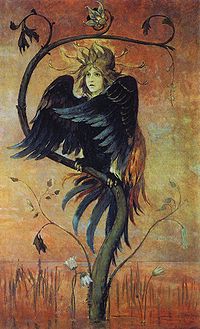Gamayun
- Gamayun
-
Gamaïoun
Dans la mythologie slave, Gamaïoun (en russe : Гамаюн) est un oiseau prophétique immortel avec une tête de femme. Elle est un des oiseaux du folklore russe avec Alkonost et Sirin. Dans plusieurs traditions folkloriques, incluant celles de Russie, ces oiseaux ont une place spirituelle significative, se situant entre le monde de la vie et celui de la mort. Elle sait tout sur la création de la terre et du ciel, des dieux et des héros, des hommes, des monstres, des oiseaux et des animaux. Elle chante des hymnes divins aux hommes et prédit l'avenir à ceux qui savent l'écouter. D'après la légende, il est difficile d'entendre les augures de Gamaïoun car ces derniers se fondent dans le bruit de l'orage. Elle vit sur une île qui se situe à l'est, proche du Paradis. Gamaïoun symbolise ainsi la sagesse et la connaissance. Cet oiseau est semblable au Phœnix et ses cris portent bonheur.
Dans sa cosmographie chrétienne bouddhiste ésotérique Roza Mira, Daniil Andreev maintient que Sirin, Alkonost et Gamaïoun se sont transformés en Archanges au Paradis.
Viktor Vasnetsov à réalisé une peinture de cet oiseau mythique en 1897. Une image de la version de Vasnetsov datant de 1889 inspira le poète Alexandre Blok. Ce dernier écrit une poésie qui fut composée en musique par Dmitri Chostakovitch en 1967 (opus 127-2 : Sept Romances sur des poésies par Blok pour soprano, violon, violoncelle et piano).
 Portail des mythes et légendes
Portail des mythes et légendes Portail des créatures imaginaires
Portail des créatures imaginaires
Catégories : Créature fantastique de la mythologie slave | Créature thérianthrope | Créature ailée
Wikimedia Foundation.
2010.
Contenu soumis à la licence CC-BY-SA. Source : Article Gamayun de Wikipédia en français (auteurs)
Regardez d'autres dictionnaires:
Gamayun — is a prophetic bird of Russian folklore. It is a symbol of wisdom and knowledge and lives on an island in the east, close to paradise. Like the Sirin and the Alkonost, the Gamayun is normally depicted as a large bird with a woman s head.In his… … Wikipedia
Slavic mythology — is the mythological aspect of the polytheistic religion that was practised by the Slavs before Christianisation. The religion possesses many common traits with other religions descended from the Proto Indo European religion. Zbruch Idol. Contents … Wikipedia
Alconost — Alkonost L Akonost d Ivan Bilibine Sommaire 1 Description … Wikipédia en Français
Alkonost — Pour les articles homonymes, voir Alkonost (groupe). L Akonost d Ivan Bilibine Sommaire … Wikipédia en Français
Perun — This article is about a Slavic god. For historical money, see Perun (money). Perun spring, east, fertility, athmosphere, thunderbolt Symbol fire, oak, iris, eagle, axe Consort Perunika or Mokosh Christian equivalent Elijah … Wikipedia
Prince Marko — Marko Марко King of the Serbian Land (only de jure) King Marko on a fresco above the south entrance to the church of Marko s Monastery near Skopje. He was a ktetor of this monastery … Wikipedia
Chernobog — is a Slavic deity, about whom much has been speculated but little can be said definitively. The name may also be given as Crnobog, Czernobóg, Černobog, Црнобог, Zernebog and Чернобог, meaning black god. The only historical sources, which are… … Wikipedia
List of fictional birds — Birds in legends, mythology, and religion= Swan Maiden a mythical creature who shapeshifts from human form to swan form. Appears in various traditions. Abrahamic mythology Judeo Christian * Noah s Dove * Noah s Raven * Ravens who fed Elijah… … Wikipedia
Jarilo — (Cyrillic: Ярило or Јарило; Polish: Jaryło; Croatian: Jura or Juraj; Serbian: Đorđe; Slavic: Jarovit), alternatively Yarilo, Iarilo, or Gerovit, was a major male Proto Slavic deity of vegetation, fertility and spring, also associated with war and … Wikipedia
Marzanna — An artist s impression of Morana with Vesna. Maržanna, Mara, Maržena, Morana, Moréna, Mora, Marmora or Morena is a Slavic goddess associated with death, winter and nightmares. Some sources equate her with the Latvian goddess Māra, who takes a… … Wikipedia


